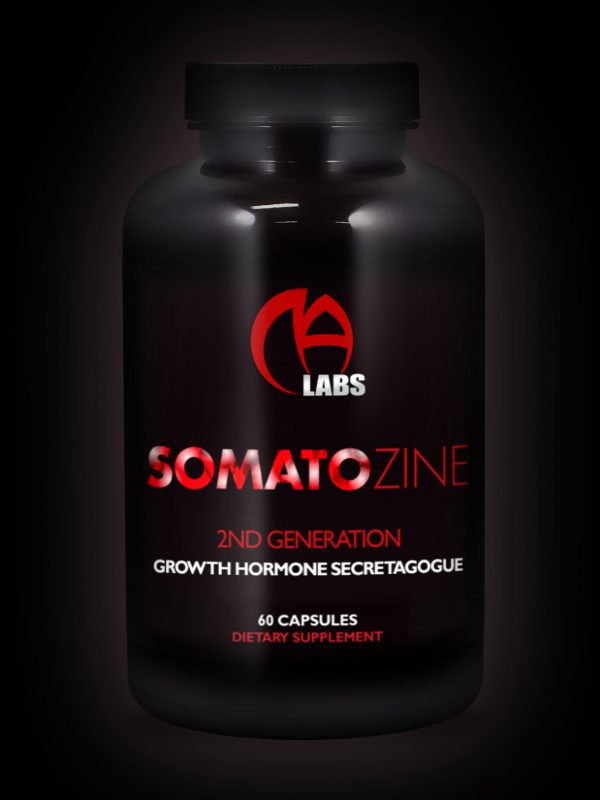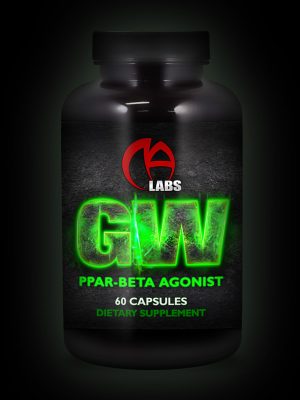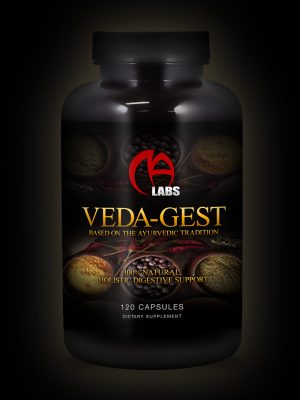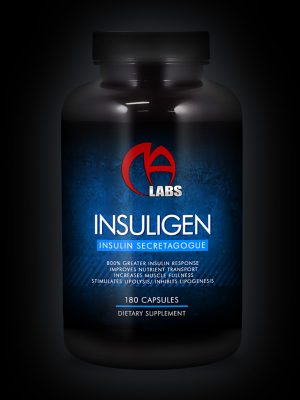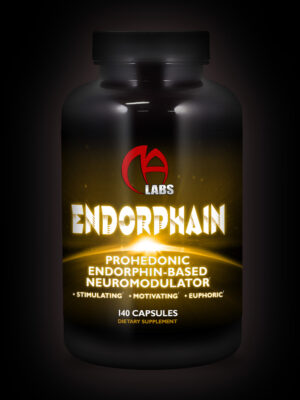Description
Somatozine
MK-677 (Enhanced)
“Growth Hormone Super Secretagogue”
Somatozine at a Glance….
• The Most Effective Growth Hormone Product on the Market
• Comparable to 4-5 iu of Pharmacy-Grade Growth Hormone per Day
• Potentiates the Anabolic Effect of Growth Hormone in Muscle Tissue
• Up-Regulates Hepatic IGF-1 Conversion Rates
• Improves IGF-1 Bioavailability
• Increases IGF-1 Half-Life
• Increases IGF-1 Receptor Density in Muscle Tissue
• Raises Free Growth Hormone Levels
• Lowers Cortisol Levels
• Increased Convenience (capsules are easier to take, store, and transport than liquid preparations)
• No Nasty After-taste!
• Superior Value (you get more for your money than with any other MK-677 product on the market, period)
A Bold Claim
For those of you who are familiar with traditional MK-677 products, there is probably a single question running through your mind right now. “What makes your MK-677 product better than the rest?” For those of you who are not already aware, MK-677 is widely regarded as the single most effective growth hormone elevating compound in the world. Aside from its sheer potency, both its oral bioavailability and long duration of action have made it a favorite among bodybuilders and fitness enthusiasts everywhere, allowing one to obtain all the benefits of exogenous growth hormone without the hassle, cost, or legal issues associated with prescription/injectable medications.
Genuine MK-677 is sold by 100’s of vendors worldwide, but with product differentiation almost non-existent among competitors, cost tends to factor heavily into a buyer’s purchase decisions. This is not necessarily a good or bad thing, but the inevitable result of each company selling the exact same product. Well, at MA Labs good isn’t good enough. If a product can be further improved we are obligated to do so and that is exactly what we have done with Somatozine. As the world’s most comprehensive and powerful growth hormone elevating formula, Somatozine has been designed to promote increases in GH through multiple pathways, while providing MK-677 with a superior foundation from which to work its magick.
Although growth hormone provides us with several benefits directly applicable to bodybuilding, it is its ability to increase IGF-1 levels that is almost entirely responsible for its muscle building effect, and to a lesser degree, its ability to induce fat loss. Therefore, in addition to maximizing GH output, we have also taken steps to ensure the creation of an IGF-1 powerhouse without equal; a task accomplished by increasing the liver’s conversion rate of growth hormone to IGF-1, improving its bioavailability, and extending its half-life in plasma. For those of you who desire to learn more, the next few pages will reveal the individual components of the Somatozine formula and how they work in the body to deliver results beyond that of MK-677 alone.
Laying the Foundation
The first ingredient to make the list is zinc. Classified as a mineral, zinc may appear somewhat mundane in comparison to other GH/IGF-1 elevating compounds, but it would be a mistake to dismiss this fundamental element simply because of its nutritional status. In reality, zinc is one of the most well-studied and clinically validated GH/IGF-1 boosting substances in existence and plays a critical role in the functioning of the GH/IGF-1 axis. Responsible for regulating endocrine function at the most basic level, it is impossible to maximize the production and bioavailability of these hormones without optimal blood levels of this mineral present in the bloodstream.
Although many studies have documented zinc’s proficiency at increasing GH levels, of significantly greater importance is its ability to increase IGF-1 and IGFBP-3 levels, as it has a much bigger impact on these hormone than it does GH. In short, it increases IGF-1 levels beyond what would normally be possible with a given dose of GH. This disproportionate rise in IGF-1 is largely attributable to zinc’s role as an up-regulator of hepatic IGF-1 synthesis. In other words, zinc signals the liver convert a larger percentage of circulating growth hormone into IGF-1, thereby amplifying GH’s anabolic potential in muscle tissue. That sounds simple enough, but what about IGFBP-3? Although less well known than IGF-1, this carrier protein has a huge influence on the body’s ability to use IGF-1, as it positively affects both its bioavailability and stabilization in plasma by assisting in the transportation of IGF-1 to receptor sites and prolonging the molecule’s half-life in the body.
Interestingly, zinc has been demonstrated to produce this effect in both zinc-deficient and non-zinc deficient individuals. While those with zinc deficiency will generally experience the greatest benefit, its positive effects extend to both groups, with significant increases in IGF-1 and IGFBP-3 levels being noted across the board. Bodybuilders are particularly susceptible to zinc deficiency as a result of increased perspiration arising from physical activity—a major risk factor in the development of zinc deficiency. In fact, physically active people are among the most likely group to experience this, as evidenced by multiple clinical studies reporting an increased rate of hypozincemia in athletes. Lest you think that adherence to a bodybuilding diet disqualifies you from concern, allow me to share with you the following statistic. Balco Laboratories, which has been responsible for testing the trace mineral levels of more than 250,000 people (including numerous professional and Olympic athletes from virtually every sport), revealed that roughly 70% of ALL those tested had moderate to severe zinc deficiencies. Moreover, the majority of those tested were NOT athletes. Had statistics been compiled using athletes only, that number would surely have risen considerably. The take home message here is that if you engage in weight training or other forms of regular physical activity, it is likely that you are zinc deficient to at least some degree, regardless of diet.
Two other minerals of critical importance are magnesium and selenium, both of which have been shown to profoundly influence IGF-1 secretion, IGF-1 bioactivity and the trophic actions of IGF-1 on skeletal muscle. One way in which sub-optimal concentrations of these minerals might cause harm is through chronic low-grade inflammation, as the inflammatory cytokines produced during a state of deficiency send negative regulatory signals that reduce IGF-1 output, impair IGF-1 bioactivity (via reduced IGFBP-3 levels), and inhibit the actions of other anabolic hormones and growth factors. Selenium deficiency may also induce oxidative stress and promote cellular damage via a decreased concentration of selenoproteins (such as glutathione peroxidase), which has also been shown to hinder IGF-1 bioactivity. Similarly, zinc’s positive effect on IGF-1 levels may be partially attributable to its known antioxidant activity. For example, zinc and selenium may positively modulate IGF-1 release through the protection of endocrine cells; an effect achieved by limiting the production of reactive oxygen species (ROS), which in turn minimizes endocrine cell degeneration/death.
Although the connection between zinc, magnesium, selenium and IGF-1 is fairly well known, copper’s role in IGF-1 secretion and utilization is only rarely mentioned. Although the mechanisms through which copper works to stimulate IGF-1 production have not yet been fully elucidated, we do know that zinc is highly antagonistic to copper, impairing its absorption into the bloodstream. The data suggests that this antagonistic effect is due to zinc’s ability to trigger the synthesis of a copper-binding ligand (likely thionein) which isolates copper from the nutrient medium and makes absorption impossible. Although the effects of this antagonism are not immediately apparent, the end result is a copper deficiency resulting in decreased IGF-1 output.
In light of these findings, researchers believe that that inability of some individuals to respond satisfactorily to the IGF-1 elevating effects of growth hormone therapy is due to inadequate copper concentrations. So, if you use injectable GH and have noticed disproportionately low levels of IGF-1 relative to your GH dose, or you don’t seem to respond very well to the IGF-1 boosting effects of GH secretagogues, then this may be the underlying problem. In order to avoid this problem, copper should always be co-administered with zinc. Many experts consider a 15:1 ratio of zinc to copper to be ideal.
More than Just a Sleep Aide
For those of you who are familiar with sleep aides, you’ve undoubtedly heard of a product called melatonin. Frequently used as a means of eliminating jet lag or simply to improve sleep quality, melatonin is actually a complex hormone involved in a multitude of functions throughout the body. Produced in the pineal gland, it is most often known for its role in regulating the sleep-wake cycle, but scientists have recently discovered many other bodybuilding benefits.
One of these is its role in regulating the production and bioavailability of growth hormone. In a fairly recent study, test subjects who were given a 5 mg dose of melatonin experienced a rise in GH levels ranging from 132-157%. One of the mechanisms through which melatonin positively modulates GH release, and which differentiates it from the other ingredients in Somatozine, is its ability to decrease somatostatin levels. As a negative regulator of growth hormone secretion, limiting somatostatin’s influence on somatotrophs (GH producing cells) is an important step in maximizing GH levels. Thankfully for us, a single dose of melatonin was shown to decrease levels of somatostatin by 76-164%. In addition to functioning as a somatostatin inhibitor, melatonin also appears to enhance GH production by increasing the responsiveness of the pituitary gland to growth hormone releasing hormone (GHRH), as evidenced in a 1993 study from “Clinical Endocrinology”.
Melatonin also helps normalize circadian rhythms (i.e. sleep quality), which is in itself an important factor in maximizing GH release, not to mention the massive effect it has on determining our rate of cellular repair (i.e. muscle growth). As cool as this is, melatonin’s ability to improve sleep quality and boost GH levels only tells us part of the story. We must also consider the amount of GH that can actually be used by the body, as not all GH is metabolically active. Luckily for us, melatonin provides assistance in this area by increasing the amount of “free” GH in the bloodstream, indicating a reduction in GHBP’s (growth hormone binding proteins). This was confirmed when researchers found that melatonin positively alters the body’s GH/GHBP-1 ratio (GHBP-1 works to inactivate circulating growth hormone).
Unfortunately, nearly 50% of all GH in circulation is bound to these proteins, essentially rendering it worthless by preventing receptor binding. Since only free GH is biologically, even a small reduction in GHBPs will enhance its positive effects. In this sense, melatonin can be viewed as a type of GH supercharger, allowing us to get more bang for our buck from a given quantity of GH. As a side benefit, melatonin has also been shown to produce a moderate increase in IGFBP-3 levels (6-11%), while also decreasing cortisol levels. As the most catabolic hormone in the body, cortisol works through at least 4-5 different mechanisms to decrease protein synthesis and promote protein breakdown. With bodybuilders being notorious for having elevated cortisol levels, anything which helps bring them under control will have a positive impact on recovery, fat loss, and growth.
Finally, while studies often give us a pretty good idea of what to expect when using certain substances, they do not always line-up with real-world results. Therefore, whenever a study bypasses this potential issue by evaluating the end result instead of interpreting the effect that intermediary factors may have on the end result, we should pay attention. A recent study on melatonin did just that by specifically evaluating its effects on body composition, rather than its effects on our hormonal profile/function. At the conclusion of this study, melatonin was shown to produce significant gains in muscle mass and reductions in bodyfat (a few pounds each over a 12 month period) in non-trained individuals. This was big news in the scientific community, as it provided these results in the absence of a training stimulus or specialized nutrition. Keep in mind that very few compounds, outside of drugs specifically designed for muscle growth, are capable of producing these kinds of results in non-trained individuals. Basically, melatonin did this all by itself, without any outside influences contributing to the end result. Had this study been conducted in bodybuilders, it is reasonable to assume that the results would have been even more impressive.
Vitamin or Hormone?
Until recently, Vitamin D3 was viewed as just another vitamin, similar to Vitamin C, E, or B, but more recent research reveals that Vitamin D is far more than just a vitamin. In fact, Vitamin D is not really a vitamin at all, but a hormone involved in the regulation of numerous bodily systems, including both the endocrine and muscular systems. So wide-ranging are its actions that simply listing them all would require an article in itself. So, we will limit our discussion only to those which are relevant to the discussion at hand.
In short, Vitamin D is absolutely essential for maximizing IGF-1 levels and IGF-1 bioavailability. Given the abundance of literature in support of these functions, some researchers have even proposed that traditional growth hormone therapy is obsolete and should henceforth be combined with Vitamin D when attempting to normalize IGF-1 concentrations in IGF-1 deficient individuals. While Vitamin D directly increases IGF-1 levels, it also has a profound effect the body’s capacity to utilize the hormone by significantly boosting IGFBP-3 production. While researchers have yet to fully elucidate the mechanism through which these effects take place, it is hypothesized that Vitamin D is transported to the liver via portal circulation, where it is then sequentially converted to 25(OH)D (a prohormone to active Vitamin D). Afterward, it is converted to 1,25(OH)2D (the active metabolite of Vitamin D), which stimulates the synthesis of IGF1/IGFBP3 in a paracrine/autocrine fashion. Scientists have even identified a Vitamin D receptor in the promoter region for IGFBP-3, which is strongly associated with circulating IGFBP-3 levels.
Even if Vitamin D’s bodybuilding benefits ended there, there would be little to complain about, but this is really just the tip of the iceberg. So important is Vitamin D for physically active individuals that deficiency is now recognized as a limiting factor in athletic performance. But rather than spending too much time detailing every single benefit, I will simply rattle the most important ones off in short order: Vitamin D potentiates the stimulating effect of insulin and leucine on protein synthesis (i.e. it makes leucine and insulin work better), increases IGF-1 receptor density in muscle tissue, increases vitamin D3 receptor density in muscle tissue, increases insulin receptor density in muscle tissue, and even has a direct and substantial impact on muscular strength.
Widely regarded as a predictor of muscle weakness, inadequate circulating Vitamin D levels makes it nearly impossible for bodybuilders and strength athletes to optimally stimulate muscle hypertrophy/strength gains during training. This is due to the adverse effect that Vitamin D deficiency has on calcium related protein transcription, which directly impairs muscle contractile ability. Research has also shown that Vitamin D may promote increases in strength through non-genomic mechanisms, as it was recently discovered that the active form of Vitamin D has a strong affinity for the MARRS receptor (membrane-associated rapid response steroid binding protein). Regardless, it is a readily accepted fact that sub-optimal Vitamin D concentrations is a detriment to performance—on multiple levels.
Before moving on it is important to note that Vitamin D deficiency is considered a world-wide epidemic by health authorities and is not limited only to those nations with a limited food supply. To the contrary, developed nations are much more likely to suffer from this condition, as the body’s main source of Vitamin D is not the diet, but the sun. So, unless you are getting ample amounts of sunlight on a consistent basis (something very few people do in modernized countries), you are almost certainly in a state of deficiency, which makes you a prime candidate for Vitamin D supplementation.
Capsule or Liquid?
Although some may try to convince you otherwise, there are virtually zero benefits attached to liquid preparations, not to mention they exhibit a variety of negative characteristics that aren’t found in their encapsulated counterparts. You see, capsules are not only easier to take, but they allow for greater transportability, increased storage options, and they certainly taste a whole lot better.
Furthermore, with nearly all liquid versions being sold by peptide-research companies, none of these products are manufactured within GMP facilities, making the quality control process a matter of owner discretion. Even worse, certain aspects of this process are outside of the owners’ control entirely, leaving the consumer at the mercy of chance. This is not an attempt to disparage these home-based companies, as I believe the majority do care about putting out a quality product (a truth reflected at least partially in the results of their customers), but simply a recognition of the facts. There is a distinct advantage to having products made within GMP facilities. From the enforcement of quality control measures, to the advanced equipment employed, supplement companies must constantly adhere to numerous rules and regulations if they wish to legally sell their products to the general public. When a product is manufactured clandestinely, there is no oversight or accountability outside of one’s own moral code. So, at the very least, having a product manufactured according to FDA guidelines should provide an extra measure of security for the buyer.
An Easy Choice
When I decided to bring Somatozine to the bodybuilding-fitness community my main goal was to provide the best possible growth hormone product at the best price. As a product bearing my name, I would not have accepted anything less. Fortunately, this goal was accomplished in full, as Somatozine not only works better than the competition, but its pricing has been set below that of other (inferior) MK-677 products. If you’re wondering why I am selling a product that costs more to make for less money, the reason is simple. I wanted to leave you, the customer, with zero reason to buy elsewhere. This approach is a win-win for all of us.
If you want to experience the muscle volumizing, fat burning, recovery enhancing effects of injectable growth hormone at a fraction of the cost, while avoiding the potential legal conundrums and pituitary shutdown that accompanies those drugs, then you will be more than pleased with Somatozine—the only once-per-day GH secretagogue clinically proven to provide results on par with injectable growth hormone. As the only enhanced version of MK-677 currently available, Somatozine reigns supreme as the most effective product in its class.
REFERENCES:
https://www.ncbi.nlm.nih.gov/pubmed/25759961
https://www.ncbi.nlm.nih.gov/pubmed/21675994
http://ajcn.nutrition.org/content/81/5/1163.full
https://www.ncbi.nlm.nih.gov/pubmed/23426817
https://www.ncbi.nlm.nih.gov/pubmed/8532589
https://www.ncbi.nlm.nih.gov/pubmed/26595309
https://www.ncbi.nlm.nih.gov/pmc/articles/PMC3963695/
http://www.mdpi.com/2072-6643/5/10/4184/htm#B93-nutrients-05-04184
http://jn.nutrition.org/content/133/2/442.full
https://www.ncbi.nlm.nih.gov/pubmed/12566481
https://www.ncbi.nlm.nih.gov/pubmed/26631054
https://www.ncbi.nlm.nih.gov/pubmed/8370132
https://www.ncbi.nlm.nih.gov/pubmed/19301769
https://www.ncbi.nlm.nih.gov/pmc/articles/PMC2174513/
https://www.ncbi.nlm.nih.gov/pubmed/26352863
https://www.ncbi.nlm.nih.gov/pubmed/10548874
http://www.eje-online.org/content/169/6/767.full.pdf
https://www.ncbi.nlm.nih.gov/pubmed/23789983
https://www.ncbi.nlm.nih.gov/pmc/articles/PMC3289217/
https://www.ncbi.nlm.nih.gov/pubmed/23929734
https://www.ncbi.nlm.nih.gov/pmc/articles/PMC4319264/

